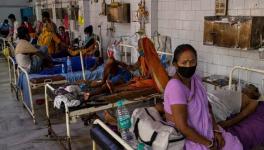Huge COVID-19 Surge in India Entails Enhanced Monitoring, Testing, Sequencing: Says Expert
The COVID-19 situation in India has become complicated as the second wave has caused a surge in new cases. In this week (March 24 to 31), the daily new cases recorded are consistently above 50,000. Eight Indian states account for over 84% of the fresh cases, with Maharashtra at the top followed by Karnataka, Punjab, Madhya Pradesh, Gujarat, Kerala, Tamil Nadu and Chattisgarh
While India is undertaking a large scale vaccination drive, the new surge in fresh cases have raised concerns, forcing even the member (Health) of Niti Aayog, V.K Paul, to remark that India’s current COVID-19 situation has gone from “bad to worse”.
In many parts of the world, a second wave has already led to the rise of alarming health situations. The emergence of new strains are also considered as a reason behind the rapid surge in fresh cases. Scientists have earlier said that some of the new variants or strains of the novel coronavirus are more contagious and hence can bring out huge numbers of new infection cases.
In India too, new variants have been reported to be circulating in different parts of the country. Not only that, India also has a “double mutant” variant present in 18 states, according to official data. Around 10,787 samples from 18 Indian states also showed 771 cases of known variants - 736 of the UK, 34 of the South African and one Brazilian, according to a BBC report.
But, to what extent the new variants are impacting the current surge is still not clear. Moreover, there is still not enough sequencing data of the virus that has been obtained from the infected people.
Also read: India’s Second ‘Wave’: Of Short-Term Measures and COVID Fatigue
Talking about the sudden and rapid surge of COVID-19 cases in the country, noted immunologist and adjunct faculty of IISER, Pune, Satyajit Rath told NewsClick, “If we look at the daily case numbers over the past few months, it is quite clear that while the numbers declined over winter, the decline had slowed down almost to a plateau. Also, simply looking at case numbers by political geography (country, state, city) misses the fact that the virus spreads by exchange of breath in communities and neighbourhoods, and those changed over time. As some neighbourhoods became mostly 'virus-experienced', infection slowly, fitfully, began to come up in other neighbourhoods. As people became more and more fatigued and less and less careful, virus variants came up that are more and more efficient at transmission (not necessarily at causing more serious illness!)”.
He also raised concerns about the government’s attitude towards tackling the rising cases. “Governments (certainly the governments in India) began declaring 'victories' in their determined view of the epidemic as a short-term problem (cutting back on testing, tracing, isolation, tracking, and livelihood support on the one hand, and avoiding sequencing, long-term vaccine development efforts, and long-term public health care commitments on the other hand). As such, these community-based outbreaks of virus have begun to spread more and more rapidly, to the point that increases in aggregate numbers are now accelerating,” he said.
According to him, even if reports of the presence of new variants in India have come out, there is still no information as to whether the new surge is due to the new variants because of low sequencing rate.
Also read: COVID-19 Situation Turning from Bad to Worse, Whole Country at Risk: Centre
Earlier when the UK variant was found in India in only a few cases, a NewsClick report had raised the possibility that the new variant could have entered India earlier than it was detected.
On being asked if India missed more than what was known, Prof Rath said, “Certainly it is possible that things have been missed; since India's virus sequencing efforts, in the proper framework of molecular epidemiology, are still nowhere near what they need to be either in competence or in scale! The reality is that we simply do not know what factors have contributed just how much to the present acceleration of spread, in significant part because we have not been doing the work needed.”
He added that at this crucial juncture, India has to enhance monitoring, testing and sequencing, while at the same time, mere chest thumping and some overtly glorified proclamations are of no serious use.
Detailed sequencing requires considerable expenses, which has often led to apprehensions on conducting these studies on a large scale. Talking about this, Rath said, “Yes, we need to do it as well. I find it sadly interesting that we, all over the world, think of the expense when it comes to people's health, but not so much when it comes to buying high-end military hardware. Although that position is consistent, I suppose, since we seem to be somewhat less enthusiastic about buying things that soldiers need to remain healthy and well-functioning, too.”
Get the latest reports & analysis with people's perspective on Protests, movements & deep analytical videos, discussions of the current affairs in your Telegram app. Subscribe to NewsClick's Telegram channel & get Real-Time updates on stories, as they get published on our website.

















